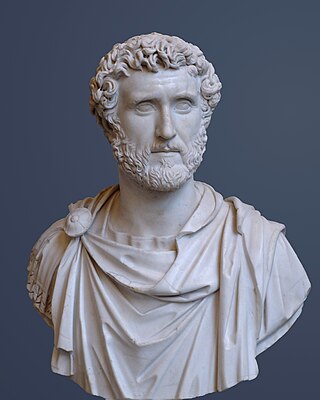Related Research Articles

Titus Aelius Hadrianus Antoninus Pius was Roman emperor from 138 to 161. He was the fourth of the Five Good Emperors from the Nerva–Antonine dynasty.

Marcus Aurelius Antoninus was Roman emperor from 161 to 180 AD and a Stoic philosopher. He was a member of the Nerva–Antonine dynasty, the last of the rulers known,but later, as the Five Good Emperors and the last emperor of the Pax Romana, an age of relative peace, calm, and stability for the Roman Empire lasting from 27 BC to 180 AD. He served as Roman consul in 140, 145, and 161.

Pope Telesphorus was the bishop of Rome from c. 126 to his death c. 137, during the reigns of Roman Emperors Hadrian and Antoninus Pius. He was of Greek ancestry and born in Terranova da Sibari, Calabria, Italy.

Lucius Aelius Caesar was the father of Emperor Lucius Verus. In 136, he was adopted by Hadrian and named heir to the throne. He died before Hadrian and thus never became emperor. After Lucius' death, he was replaced by Antoninus Pius, who succeeded Hadrian the same year.

The gens Aurelia was a plebeian family at ancient Rome, which flourished from the third century BC to the latest period of the Empire. The first of the Aurelian gens to obtain the consulship was Gaius Aurelius Cotta in 252 BC. From then to the end of the Republic, the Aurelii supplied many distinguished statesmen, before entering a period of relative obscurity under the early emperors. In the latter part of the first century, a family of the Aurelii rose to prominence, obtaining patrician status, and eventually the throne itself. A series of emperors belonged to this family, through birth or adoption, including Marcus Aurelius and the members of the Severan dynasty.
William "Bill" Everson, also known as Brother Antoninus, was an American poet, literary critic, teacher and small press printer. He was a member of the San Francisco Renaissance.

Antoninus of Florence, was an Italian Dominican friar, who ruled as an archbishop of Florence. He is venerated as a saint by the Catholic Church.

The Nerva–Antonine dynasty comprised seven Roman emperors who ruled from 96 to 192 AD: Nerva (96–98), Trajan (98–117), Hadrian (117–138), Antoninus Pius (138–161), Marcus Aurelius (161–180), Lucius Verus (161–169), and Commodus (180–192). The first five of these are commonly known as the "Five Good Emperors".

The Temple of Antoninus and Faustina is an ancient Roman temple in Rome, which was later converted into a Roman Catholic church, the Chiesa di San Lorenzo in Miranda or simply "San Lorenzo in Miranda". It is located in the Forum Romanum, on the Via Sacra, opposite the Regia.
Gnaeus Arrius Antoninus was the maternal grandfather of the Emperor Antoninus Pius.
Saint Antoninus may refer to:
The anonymous pilgrim of Piacenza, sometimes simply called the Piacenza Pilgrim, was a sixth-century Christian pilgrim from Piacenza in northern Italy who travelled to the Holy Land at the height of Byzantine rule in the 570s and wrote a narrative of his pilgrimage. This anonymous pilgrim was erroneously identified as Antoninus of Piacenza or Antoninus Martyr out of confusion with Saint Antoninus of Piacenza, who died in 303 and is venerated as a martyr.

Gaius Julius Sohaemus was a Roman client king of Armenia.
In Greek mythology, Periphas was a legendary king of Attica, whom Zeus turned into an eagle. Aside from a passing reference in Ovid's Metamorphoses, the only known source for this story is the second century AD or later Metamorphoses of Antoninus Liberalis.
In Greek mythology, Acanthus was the son of Autonous and Hippodamia. He was the brother of Acanthis, Erodius, Anthus and Schoeneus. The bird he turned into has been identified as the siskin, the linnet, the blue tit or other birds, but with little certainty. Perhaps he is supposed to be the male of the bird his sister Acanthis turned into.

St Antoninus Giving Alms or The Alms of St Antoninus is an oil-on-canvas painting by the Italian artist Lorenzo Lotto, created c. 1540–1542. It depicts Archbishop Antoninus of Florence giving alms as an allegorical ideal for bureaucratic charity. The painting is now displayed in the Basilica dei Santi Giovanni e Paolo in Venice.
in Greek mythology, Timandra is a widow woman who became the lover of Aegypius.
In Greek mythology, Bulis is a minor figure who partook in accidental incest with her own son, Aegypius.
In Greek mythology, Neophron is a minor mythological character, who, in order to take revenge against Aegypius seducing his mother Timandra, seduced Aegypius's own mother Bulis. His myth is preserved in the works of Antoninus Liberalis.
In Greek mythology, Megaletor is a minor figure, a prince of the Molossians, who was transformed into a bird by the will of Zeus, the god of justice, in order to escape a fiery death.
References
- ↑ St. Antoninus Catholic Online